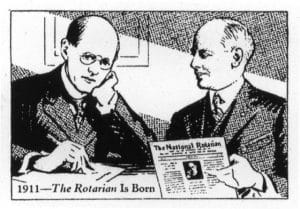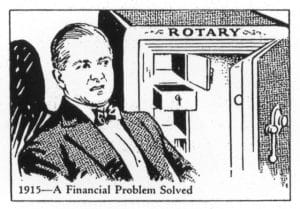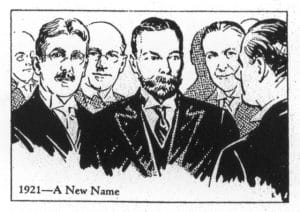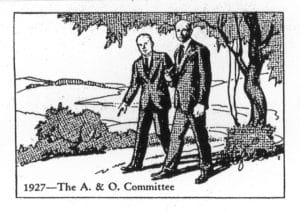Wolfgang Ziegler Collection
The Rotarian History
“We live in the present, we dream of the future,
but we learn from the past.”
Guest Editorial
(From the February, 1949 issue of The Rotarian)
Here’s One Man’s Collection of Pivotal Events
in the Development of the movement. What is yours?
By Ralph S. Dunne (1) Chairman,
Districting Committee of Rotary International
When Madame Chiang Kai-shek² spoke at Madison Square Garden in New York City a few years ago, she significantly said, “We live in the present, we dream of the future, but we learn from the past.” What a lesson that holds for Rotarians! “What is past is prologue to the future” ‑ yet how many of us know the dramatic incidents which have provided milestones in the development of Rotary?
There are many Rotarians today who are deeply concerned about the future. They feel that we are in the midst of another crisis when we must soon decide whether we shall again emphasize the importance of individual action, or see Rotary largely expressed through corporate action. They insist that Rotary as an organization must “do something.”
How many know, for example, that Rotary faced a great crisis in 1913 and again in 1923? Had very wise decisions not been made, possibilities for future usefulness and growth might very well have been destroyed. And how many know the interesting story back of the selection of the name “Rotary International”?
Let us, then, glance back and from the lessons of the past be fortified and guided in making the decisions today which many believe are necessary if Rotary is to go forward to greater influence.
 1911 ‑ The Rotarian Is Born. Early in 1911 Paul P. Harris wrote an essay on “Rotarianism” which he thought might well be distributed to the handful of Rotarians in the United States. Secretary Chesley R. Perry had the bright idea of publishing it in a periodical which might or might not continue. Before long The National Rotarian, Vol. 1, No. 1, journeyed forth with Paul Harris’ message, together with news of Club activities, personal items, and editorials.
1911 ‑ The Rotarian Is Born. Early in 1911 Paul P. Harris wrote an essay on “Rotarianism” which he thought might well be distributed to the handful of Rotarians in the United States. Secretary Chesley R. Perry had the bright idea of publishing it in a periodical which might or might not continue. Before long The National Rotarian, Vol. 1, No. 1, journeyed forth with Paul Harris’ message, together with news of Club activities, personal items, and editorials.
The underlying significance of the inauspicious event in 1911 is that a device was created which recognized the importance of the individual Rotarian, irrespective of Club, District, national, or geographic lines, for the official magazine goes from the center of the organization directly to the individual Rotarian. We can today say of our magazine what someone said of Shakespeare: it “needs not praise but comprehension only.”
 1913 ‑ The First Crisis. For several years after Rotary was founded by Paul Harris, February 23, 1905, great emphasis was placed on advancing the business interests of Rotarians by sharing business with each other. Some Clubs actually designated a Rotarian to act as statistician, who kept a record of business each member received from others. At the 1913 Convention in Buffalo, New York, President Glenn C. Mead made very clear what some Rotarians had been thinking and saying ‑ viz., that Rotary could not survive if this selfish approach continued. He declared that service rather than material gain should be the cardinal principle of Rotary. And his views were strongly supported by Frank L. Mulholland, Russell F. Greiner, and Allen D. Albert, all of whom later became Presidents.
1913 ‑ The First Crisis. For several years after Rotary was founded by Paul Harris, February 23, 1905, great emphasis was placed on advancing the business interests of Rotarians by sharing business with each other. Some Clubs actually designated a Rotarian to act as statistician, who kept a record of business each member received from others. At the 1913 Convention in Buffalo, New York, President Glenn C. Mead made very clear what some Rotarians had been thinking and saying ‑ viz., that Rotary could not survive if this selfish approach continued. He declared that service rather than material gain should be the cardinal principle of Rotary. And his views were strongly supported by Frank L. Mulholland, Russell F. Greiner, and Allen D. Albert, all of whom later became Presidents.
As a result of this forceful emphasis, the concept of “the importance of the individual” took on a new meaning in Rotary.
 1915 – A Financial Problem Solved. Rotary was almost bankrupt in 1915: Frank Mulholland, then President, realizing the seriousness and urgency of the situation, conceived the simple idea of asking Rotarians each to contribute a dollar. This commonsense method of raising a sizable amount of money proved quite successful; Rotary has not been financially embarrassed since that time.
1915 – A Financial Problem Solved. Rotary was almost bankrupt in 1915: Frank Mulholland, then President, realizing the seriousness and urgency of the situation, conceived the simple idea of asking Rotarians each to contribute a dollar. This commonsense method of raising a sizable amount of money proved quite successful; Rotary has not been financially embarrassed since that time.
1921 ‑ A New Name. In June, 1921, President Crawford C. McCullough headed a group of Rotarians who had an audience with King George V at Buckingham Palace. Among those present were Guy Gundaker, Glenn Mead, Frank Mulholland, Arch C. Klumph, Rufus F. Chapin, and Arthur Chadwick. After Rotary ideals had been explained to King George he is reported to have said, “I want to see Rotary International spread to every corner of the British Empire.”
 In 1921, when a Committee of Thirty‑One met in Chicago to rewrite the Constitution and Bylaws of Rotary, someone must have recalled that interview with King George. “Why not,” he asked, “change our name from the International Association of Rotary Clubs to Rotary International?” The idea caught on and “Rotary International” was written into the Constitution adopted at the 1922 Convention in Los Angeles. In the light of what has transpired since, many believe that the movement was given impetus and vision by this action.
In 1921, when a Committee of Thirty‑One met in Chicago to rewrite the Constitution and Bylaws of Rotary, someone must have recalled that interview with King George. “Why not,” he asked, “change our name from the International Association of Rotary Clubs to Rotary International?” The idea caught on and “Rotary International” was written into the Constitution adopted at the 1922 Convention in Los Angeles. In the light of what has transpired since, many believe that the movement was given impetus and vision by this action.
 1923 ‑ Another Crisis Met. It was not long after Rotary was founded that Paul Harris expressed the hope that Rotary Clubs would embark on a program of civic activities and community betterment. Boys work in aiding crippled children so captured the imagination that many had come to believe it to be the whole work of Rotary. The Convention at St. Louis in 1923 debated the question, then adopted the now‑famous Resolution 34, which clarified our thinking by stipulating that:
1923 ‑ Another Crisis Met. It was not long after Rotary was founded that Paul Harris expressed the hope that Rotary Clubs would embark on a program of civic activities and community betterment. Boys work in aiding crippled children so captured the imagination that many had come to believe it to be the whole work of Rotary. The Convention at St. Louis in 1923 debated the question, then adopted the now‑famous Resolution 34, which clarified our thinking by stipulating that:
No Club should allow any Community Service activities to obscure the Objects of Rotary or jeopardize the primary purpose for which a Rotary Club is organized.
Activities which enlist the individual efforts of all Rotarians generally are more in accord with the genius of Rotary than those only requiring the mass action of the Club, because the Community Service activities of a Rotary Club should be regarded only as a laboratory experiment designed to train members of a Rotary Club in service.
Again the importance of the individual Rotarian can be seen influencing the course for the future of Rotary.
 1927 ‑ The A. & 0. Committee. While the Aims and Objects Plan was adopted by Rotary International at the Ostend, Belgium, Convention in 1927, its history goes back several years to one Sunday morning. Sydney W. Pascall, then President of Rotary International in Great Britain and Ireland, and Vivian Carter were walking through a woods in Surrey, England, and the discussion turned to Rotary education. Sydney deplored the Rotary ignorance of the average Rotarian, and outlined a plan to make the Rotary Educational Committee more effective.
1927 ‑ The A. & 0. Committee. While the Aims and Objects Plan was adopted by Rotary International at the Ostend, Belgium, Convention in 1927, its history goes back several years to one Sunday morning. Sydney W. Pascall, then President of Rotary International in Great Britain and Ireland, and Vivian Carter were walking through a woods in Surrey, England, and the discussion turned to Rotary education. Sydney deplored the Rotary ignorance of the average Rotarian, and outlined a plan to make the Rotary Educational Committee more effective.
These two men later exchanged letters which led finally to the putting down on a half sheet of paper what became known later as the Aims and Objects Plan. The scheme was tried out for 12 months in the Rotary Clubs of Britain and Ireland and more than half the Clubs adopted it. Later Vivian came to Chicago and, using a blackboard, explained the plan to the Board, which submitted it to the Ostend Convention.
It is interesting to note that the original A. & 0. Plan contemplated only three lines of activity: Club Service, Community Service and Boys Work, and Vocational Service. In 1928, at Minneapolis, International Service was added.
At Nice, France, in 1937 the Bylaws were again amended to do away with the separate Committees for the Services. Now one member of the Aims and Objects Committee is responsible for each of the four.
 1933 ‑ Revista Rotaria. The first of what may be several non‑English editions of THE ROTARIAN, very appropriately named REVISTA ROTARIA, was published in Spanish. Since then it has gained steadily in reader interest and has been a major factor in the growth of Rotary in Ibero‑America.
1933 ‑ Revista Rotaria. The first of what may be several non‑English editions of THE ROTARIAN, very appropriately named REVISTA ROTARIA, was published in Spanish. Since then it has gained steadily in reader interest and has been a major factor in the growth of Rotary in Ibero‑America.
1949 ‑ Where Tomorrow?
There are many Rotarians today who are deeply concerned about the future. They feel that we are in the midst of another crisis when we must soon decide whether we shall again emphasize the importance of individual action, or see Rotary largely expressed through corporate action. They insist that Rotary as an organization must “do something.”
Those who make these demands fail to realize that Rotary’s position and influence in the world will never be more than the reflection of the individual Rotarian. The individual’s application of Rotary’s ideals is, it seems to me, more important than corporate activities at the Club or top level.
We don’t have to sponsor something to make Rotary a living force. We can individually make it so. There is truth in the statement that “Through the power of the individual a new age will stir and be formed. No new age has been formed in any other way.”
The great opportunity facing the more than 320,000 Rotarians today is to expand the area of decency and understanding in all the relationships of life among all the peoples of the world. This is enough to command our best thinking and acting.
What we do as individuals in giving life and meaning to Rotary is the only worthy measuring rod by which we should want the world to judge us.
Madge Jenison³ once said, “Give the world something with character and it will carry your name to the sunset.” If we, as Rotarians, live up in full measure to the opportunities and responsibilities of Rotary membership, we can truly hope that the world will carry the name of Rotary to the sunset, The road will be easier and the pace quicker if we learn from the lessons of the past 44 years.
¹ Ralph S. Dunne , RC Bala Cynwyd-Narbeht, was Governor of District 179 in 1945-46
² Soong Mei-ling (1897 – 2003) was born in China and educated in the United States. She married Chiang Kai-shek in 1927. In 1943, she spoke before the United States congress. She is considered one of the most politically important women in history.
³ Madge Jenison (1874 – 1960) was an American author who wrote novels, short stories and scripts.
Prepared for Rotary Global History by historian
Dr. Wolfgang Ziegler 27 November 2005
